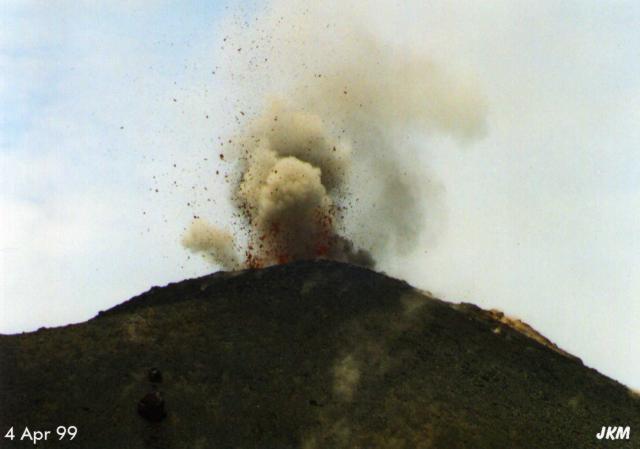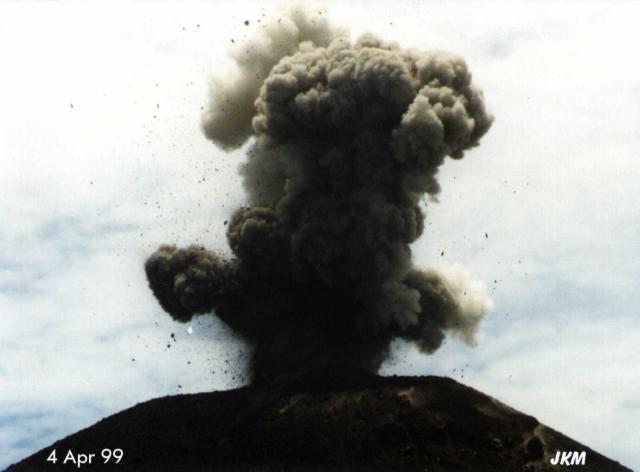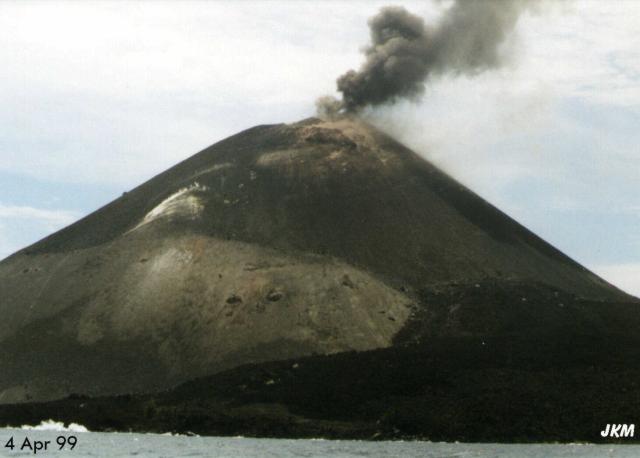Report on Krakatau (Indonesia) — April 1999
Bulletin of the Global Volcanism Network, vol. 24, no. 4 (April 1999)
Managing Editor: Richard Wunderman.
Krakatau (Indonesia) Explosive eruptions continue in April
Please cite this report as:
Global Volcanism Program, 1999. Report on Krakatau (Indonesia) (Wunderman, R., ed.). Bulletin of the Global Volcanism Network, 24:4. Smithsonian Institution. https://doi.org/10.5479/si.GVP.BGVN199904-262000
Krakatau
Indonesia
6.1009°S, 105.4233°E; summit elev. 285 m
All times are local (unless otherwise noted)
After a repose of twenty months Anak Krakatau erupted again at 1615 on 5 February (BGVN 24:02). Several scientists, including some from the Volcanological Survey of Indonesia (VSI) and from Unocal Geothermal of Indonesia, visited Krakatau from 28 March to 6 April. This report combines their observations.
Seismic activity preceding and coincident with the eruption went undetected because of ballistic bomb damage to seismometers. Until 3 April, activity typically involved 5-10 explosions per day. Beginning at about 1500 on 3 April ash explosions became almost continuous (figures 12 and 13). During the interval 0955-1230 on 4 April, the volcano erupted every 1-3 minutes from a new crater a few hundreds of meters S of the summit crater that formed during 1992-97. Accidental blocks, lava bombs, and ash reached heights of 250-300 m above the crater rim. About a third of the eruptions were Strombolian, with showers of lava and bombs (occasionally 1 m across) ejected 50-100 m above the vent and falling onto the upper flanks. Some ballistic fragments 20-30 cm in diameter rose above the associated ash cloud and landed 800 m from the vent on the upper flanks before rolling down to the shore. Eruptions were often accompanied by thunderous blasts and rumbling sounds heard several kilometers from the crater, including at Pasauran and Kalianda observatories 42 km from Krakatau.
 |
Figure 12. Lava and bombs exploded from the summit of Anak Krakatau on 4 April. This view was from the sea looking toward the E. Courtesy of VSI; photo by Karsten Moran, Jakarta International School. |
A wedge-shaped deposit of fresh ash and bombs was visible on the crater rim (the rim is higher on the SE due to prevailing northwesterly winds that blow ash and other ejecta in that direction). Ash clouds were light gray. Observers noticed fine black ash that fell on their boat as they passed under the plumes ~500 m downwind from the crater. The ash was crystal-poor and frothy, suggesting that it was mostly juvenile material.
A solfataric plume originating at ~200 m elevation on the N flank discharged steam and bluish gas. Nearly a dozen other solfataras discharged steam and non-condensible gas and deposited bright yellow native sulfur around vents near the summit (figure 14). Another fumarolic area was centered at 140 m elevation on the W flank below the active crater.
Scientists observed several boatloads of tourists who had landed on the accessible SE beach. Officials had closed an area of 3 km radius around the vent, but many tourists defied the prohibition and climbed to the ridge 400 m from the summit vents. Escaping gases continued to pose a very serious hazard.
The renowned Krakatau volcano lies in the Sunda Strait between Java and Sumatra. Caldera collapse, perhaps in 416 AD, destroyed the ancestral Krakatau edifice, forming a 7-km-wide caldera. Remnants of this volcano formed Verlaten and Lang Islands; subsequently Rakata, Danan and Perbuwatan volcanoes were formed, coalescing to create the pre-1883 Krakatau Island. Caldera collapse during the catastrophic 1883 eruption destroyed Danan, and Perbuwatan volcanoes, and left only a remnant of Rakata volcano. The post-collapse cone of Anak Krakatau (Child of Krakatau), constructed within the 1883 caldera at a point between the former cones of Danan and Perbuwatan, has been the site of frequent eruptions since 1927.
During six lava-producing eruptions between 1958 and 1980, flows moved S and SW from the SW crater. Observations are frequently made from Carita Beach on the coast of Java, ~40 km E. The local VSI volcano observatory is at Pasuaran, ~42 km E.
Geological Summary. The renowned Krakatau (frequently mis-named as Krakatoa) volcano lies in the Sunda Strait between Java and Sumatra. Collapse of an older edifice, perhaps in 416 or 535 CE, formed a 7-km-wide caldera. Remnants of that volcano are preserved in Verlaten and Lang Islands; subsequently the Rakata, Danan, and Perbuwatan cones were formed, coalescing to create the pre-1883 Krakatau Island. Caldera collapse during the catastrophic 1883 eruption destroyed Danan and Perbuwatan, and left only a remnant of Rakata. This eruption caused more than 36,000 fatalities, most as a result of tsunamis that swept the adjacent coastlines of Sumatra and Java. Pyroclastic surges traveled 40 km across the Sunda Strait and reached the Sumatra coast. After a quiescence of less than a half century, the post-collapse cone of Anak Krakatau (Child of Krakatau) was constructed within the 1883 caldera at a point between the former Danan and Perbuwatan cones. Anak Krakatau has been the site of frequent eruptions since 1927.
Information Contacts: Igan S. Sutawidjaja, Volcanological Survey of Indonesia (VSI), Jalan Diponegoro No. 57, Bandung 40122, Indonesia (URL: http://www.vsi.esdm.go.id); David Sussman, Unocal Geothermal of Indonesia, Sentral Senayan-1 Office Tower, 11th Floor, Jalan Asia Afrika No. 8, Jakarta 10270, Indonesia; John Moran, c/o USAID, Jalan Medan Merdeka Selatan No. 5, Jakarta 10110, Indonesia; Rene Wassill, Wisma Met. I, 5th floor, Jalan Sudirman Kav 26, Jakarta, Indonesia.



